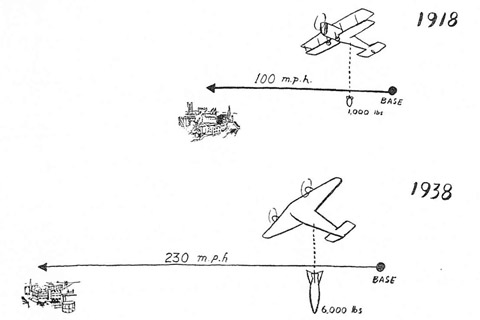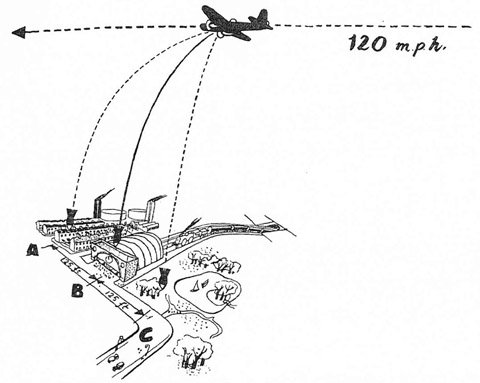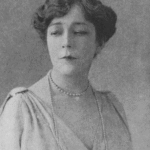I’ve previously posted some of Gorden Cullen’s artwork for the Tecton Group’s 1939 book Planned A.R.P.. Here are some more of his cute drawings dealing with an awful subject. In this case, he is illustrating the ‘general agreement among experts’ on the threat posed by the bomber.
(a) The range, speed, and carrying capacity of bombers have increased enormously since the last war.1

This was a commonplace observation and was demonstrably true, as anyone who knew anything at all about aviation would know.
(b) In order to avoid anti-aircraft fire, balloon barrages, etc., the attacking bombers will probably fly at a height of not less than 12,000 to 15,000 feet. Although the pilot might be able to dive to a much lower altitude, he would, in all probability, be afraid to do so, as the risk would not seem worth while.
This is somewhat unusual; it was more common to denigrate the effective of anti-aircraft defences. The experience of the Spanish civil war might have been responsible for this, though the author(s) do say that the war there isn’t likely much of a guide as the conditions are so different there.

(c) Owing to the good target which large concentrations of bombers offer to the defence chasers and anti-aircraft batteries, it is probable that raids will be made by small groups of planes, possibly following each other in quick succession.2
I can’t recall coming across many other predictions like this. Certainly massive aerial armadas were more the norm in predictions of the coming air war. But again it might owe something to Spain, where small-scale air actions were common.
(d) Night-time and foggy weather provide especially favourable conditions for an attacker, since they render the task of defence doubly difficult, while London, for example, is so large an area that even with the worst visibility a raider can be sure of scoring a hit on some part of it.
Quite a common prediction. Many writers suggested that bombing would like take place at night or in cloudy weather. This usually happened when they allowed that air defences might be effective (see (b) above).
(e) The very high cost of production (one French authority estimated the cost of 1,000 kg. of bombs at as much as a million francs), the limited carrying capacity of bombers (about 3 tones), and the fact that weight for weight small bombs have a higher destructive effective than large (see drawing below showing comparative areas of destruction of equivalent weights of bombs), all tend to indicate that comparatively light bombs will probably be preponderant.

This is an interesting one. It hints at the sort of operational research that the British, especially, would carry out during the war. It seems counterintuitive to argue that smaller bombs were more effective than bigger ones, but up to a point it was in fact the case, especially given the aiming problem (see (h) below).
(f) The time of warning to be expected in London is about ten minutes.
Although the precise period varied — falling over time, in accordance with (a) above — this type of prediction was very common.
(g) The possibility of gas and incendiary bombs being used must, of course, not be overlooked, especially in view of their comparatively low cost.
Interesting use of language here, that gas and incendiaries ‘must, of course, not be overlooked’. That suggests that there was a possibility that they might be, perhaps for plausible reasons. I put this down to the effectiveness of the government’s ARP campaign in the late 1930s, which focused on preparations for gas and incendiaries because they were relatively easy for householders to deal with, unlike high explosives.
(h) The extreme difficulty of hitting a given target from a high altitude is a factor making for indiscriminate bombing. For instance, a variation of 6 m.p.h. in the speed of an aeroplane travelling at a speed of 120 m.p.h. and at an altitude of 15,000 feet can make a difference of 80 yards in the the position where the bomb falls. As wind pressure and other factors cause constant variations of speed, it is practically impossible to consider accurate aiming from this altitude.3

An uncommon claim, this; it was more usual to vaguely assume pinpoint accuracy in bombing. The author seems to have had a mathematical bent, and I suspect some of the less generic predictions were his or her own more than the uncited ‘experts’ mentioned above.
And what does it all add up to?
The general inference to be drawn from these conclusions is that we must expect more or less indiscriminate bombing, with bombs of varying sizes, but mainly the smaller types, from high altitudes […]
In dismissing the likelihood of aim being taken at a particular target we refer, of course, to a target of limited size — a single building, for example — but this by no means excludes the possibility of whole districts (for instance, those containing docks, munition factories, etc.) becoming targets, in which case the difficulty of scoring a hit is enormously reduced.
Central London and similar districts of other towns must, owing to the presence of concentrations of population and of industrial and administrative centres, be recognised as constituting targets in themselves — targets which, by their very size, are far harder to defend than those of the generally accepted “military objective” type, such as power-stations and other individual buildings.4
I don’t usually play the game of ‘how accurate was that?’ but this is all pretty impressive, and the deviations from the general consensus make it more so.
![]() This work is licensed under a Creative Commons Attribution-NonCommercial-NoDerivatives 4.0 International License.
Permissions beyond the scope of this license may be available at http://airminded.org/copyright/.
This work is licensed under a Creative Commons Attribution-NonCommercial-NoDerivatives 4.0 International License.
Permissions beyond the scope of this license may be available at http://airminded.org/copyright/.





I think that I might have seen some similarly accurate predictions while trolling the prewar literature for my own obsessions. But I can’t remember, because I didn’t take not at the time!
What stands out here, stands out because the author is being sensible rather than alarmist. It’s a rare, rare quality. Someday I hope to be sensible. (Or, better yet, the first to be alarmist about the new coming thing.)
Nice find, Brett!
I’m not up enough on the literature to know – I hope to obtain a copy of The Science of Bombing sometime soon – but was the move towards larger bombs a post-Butt trend? As I understand it, the 1000-pounder became the ‘standard’ bomb by the late-war period (up from the 250-lb.), and of course there were the various ‘cookies,’ which were mainly used in conjunction with incendiaries.
Erik:
Yes, you’ve put your finger on it: it’s the non-alarmism that’s striking, when alarmism is so easy to do. I do think that’s a trend of the very late 1930s — see Shute’s What Happened To The Corbetts for another example.
Jakob:
I think it may have been earlier than Butt, but don’t quote me! Harris in Bomber Offensive seems to imply that the move towards bigger bombs started after seeing what German bombs did in the Blitz: 4000-lb and 8000-lb bombs debuted in 1941 which, depending on the month, is a bit soon for Butt. I’m sure Butt accelerated the trend though. (And yes, I’d like that book too!)